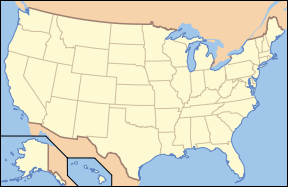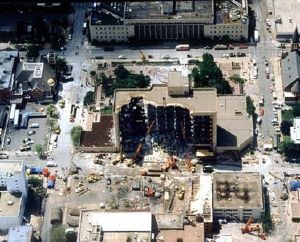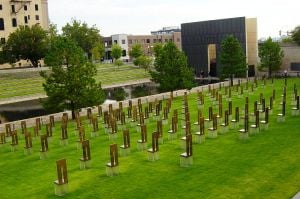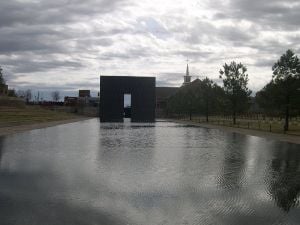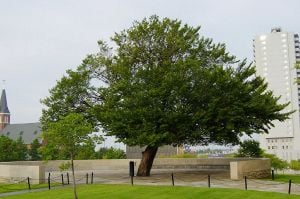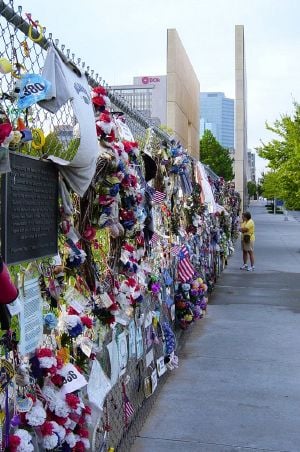Difference between revisions of "Oklahoma City National Memorial" - New World Encyclopedia
Mary Anglin (talk | contribs) |
Mary Anglin (talk | contribs) |
||
| Line 112: | Line 112: | ||
*Stein, R. Conrad. 2003. ''The Oklahoma City National Memorial''. Cornerstones of freedom. New York: Children's Press. ISBN 9780516242057 | *Stein, R. Conrad. 2003. ''The Oklahoma City National Memorial''. Cornerstones of freedom. New York: Children's Press. ISBN 9780516242057 | ||
* United States. 2001. ''The National parks: index 2001-2003''. Washington, D.C.: U.S. Dept. of the Interior. {{OCLC|53228516}} | * United States. 2001. ''The National parks: index 2001-2003''. Washington, D.C.: U.S. Dept. of the Interior. {{OCLC|53228516}} | ||
| − | *Wright, Stuart A. 2007. ''Patriots, politics, and the Oklahoma City bombing''. Cambridge studies in contentious politics. Cambridge: Cambridge University Press. ISBN 9780521872645 [http://www.cambridge.org/us/catalogue/catalogue.asp?isbn=9780521694193 Catalogue description, including summary, table of contents, and excerpts] | + | *Wright, Stuart A. 2007. ''Patriots, politics, and the Oklahoma City bombing''. Cambridge studies in contentious politics. Cambridge: Cambridge University Press. ISBN 9780521872645 [http://www.cambridge.org/us/catalogue/catalogue.asp?isbn=9780521694193 Catalogue description, including summary, table of contents, and excerpts] Retrieved December 20, 2008. |
== External links == | == External links == | ||
Revision as of 01:59, 20 December 2008
| Oklahoma City National Memorial & Museum | |
|---|---|
| IUCN Category V (Protected Landscape/Seascape) | |
| | |
| Location: | Oklahoma City, Oklahoma, USA |
| Area: | 3.3 acres (13,000 m²) (3.12 federal) 25,300 m² |
| Established: | October 9, 1997 |
| Visitation: | 500,000+ (in annually) |
| Governing body: | Oklahoma City Nat'l Memorial Foundation & National Park Service |
The Oklahoma City National Memorial is the largest memorial of its kind in the United States. It honors the victims, survivors, rescuers, and all who were changed by the Oklahoma City bombing on April 19, 1995. The memorial is located in downtown Oklahoma City on the former site of the Alfred P. Murrah Federal Building, which was destroyed in the 1995 bombing. This building was located on NW 5th street between N. Robinson Avenue and N. Harvey Avenue,
The National Memorial was established on October 9, 1997, through the signing of the Oklahoma City National Memorial Act of 1997, by President Bill Clinton, and, as with all National Park Service historic areas, was administratively listed on the National Register of Historic Places the same day. The memorial is administered by Oklahoma City National Memorial Foundation, with the National Park Service maintaining a presence at the memorial for interpretation purposes.
The National Memorial Museum and the Institute for the Prevention of Terrorism are the two components which are housed in the old Journal Record Building on the north side of the memorial grounds.
The memorial was formally dedicated on April 19, 2000 - the fifth anniversary of the bombing; the museum was dedicated the following year on February 19.
Background
The Oklahoma City bombing was a domestic terrorist attack on April 19, 1995 aimed at the U.S. government in which the Alfred P. Murrah Federal Building, an office complex in downtown Oklahoma City, Oklahoma, was bombed. The attack claimed 168 lives and left over 800 people injured. It was the first major terrorist attack and until the September 11, 2001 attacks, it was the deadliest act of terrorism on U.S. soil.
Shortly after the explosion, Oklahoma State Trooper Charlie Hanger stopped 26-year-old Timothy McVeigh for driving without a license plate and arrested him for that offense and for unlawfully carrying a weapon.[1] Within days after the bombing, Timothy McVeigh and Terry Nichols were both arrested for their roles in the bombing. Investigators determined that they were sympathizers of a militia movement and that their motive was to retaliate against the government's handling of the Waco and Ruby Ridge incidents (the bombing occurred on the anniversary of the Waco incident). McVeigh was executed by lethal injection on June 11, 2001. Nichols was sentenced to life in prison. A third conspirator, Michael Fortier, who testified against McVeigh and Nichols, was sentenced to 12 years in prison for failing to warn the U.S. government. As with other large scale terrorist attacks, conspiracy theories dispute the official claims and point to additional perpetrators involved.
The attacks led to widespread rescue efforts from local, state, and federal and worldwide agencies, along with considerable donations from across the country. As a result of the destruction of the Alfred P. Murrah Federal Building, the U.S. government passed legislation designed to increase protection around federal buildings and to thwart future terrorist attacks. Under these measures, law enforcement has since foiled sixty domestic terrorism plots.[2] On April 19, 2000, the Oklahoma City National Memorial was dedicated on the site of the Murrah Federal Building to commemorate the victims of the bombing and annual remembrance services are held at the time of the explosion.
Memorial features
The Outdoor Symbolic Memorial consists of the following segments on 3.3 acres (13,000 m²), and can be visited 24 hours a day, 365 days a year.
- The Gates of Time: Monumental twin bronze gates frame the moment of destruction - 9:02 - and mark the formal entrances to the Outdoor Memorial. 9:01, found on the eastern gate, represents the last moments of peace, while its opposite on the western gate, 9:03, represents the first moments of recovery. Both time stamps are inscribed on the interior of the monument, facing each other and the Reflecting Pool.
- The outside of each gate bears this inscription:
We come here to remember Those who were killed, those who survived and those changed forever. May all who leave here know the impact of violence. May this memorial offer comfort, strength, peace, hope and serenity.
- Reflecting Pool: A thin layer of water flowing over polished black granite, the Reflecting Pool runs east to west down the center of the Memorial on what was once Fifth Street. Visitors who see their reflection in the reflecting pool are supposed to see "a face of a person changed by domestic terrorism."
- Field of Empty Chairs: 168 empty chairs hand-crafted from glass, bronze, and stone represent those who lost their lives in the tragedy. A bombing victim's name is etched in the glass base of each chair. The chairs represent the empty chairs at the dinner tables of the victim's family. The chairs are arranged in nine rows symbolizing the nine floors of the building, and each person's chair is on the row (or the floor) on which the person worked or was visiting when the bomb went off. The chairs are also grouped according to the blast pattern, with the most chairs nearest the most heavily damaged portion of the building. The westernmost column of five chairs represents the five people who died but were not in the Murrah Building when the bomb went off (two in the Water Resources Board building, one in the Athenian Building, one outside near the building, and one rescuer). The 19 smaller chairs represent the children killed in the bombing. Three unborn children died along with their mothers, and they are listed on their mothers' chairs beneath their mothers' names.
- Survivors' Wall: The only remaining original portions of the Murrah Building are the southeast corner, known as the Survivors' Wall, and a portion of the south wall. The Survivors' Wall includes several panels of granite salvaged from the Murrah Building itself, inscribed with the names of more than 800 survivors from the building and the surrounding area, many of whom were injured in the blast.
- The Survivor Tree: An American elm on the north side of the Memorial, this tree was the only shade tree in the parking lot across the street from the Murrah Building, and commuters came in to work early to get one of the shady parking spots provided by its branches. Photos of Oklahoma City taken around the time of statehood (1907) show this tree, meaning it is currently at least 117 years old. Despite its age, the tree was neglected and taken for granted prior to the blast. Heavily damaged by the bomb, the Tree ultimately survived after nearly being chopped down during the initial investigation, in order to recover evidence hanging in its branches and embedded in its bark.
The force of the blast ripped most of the branches from the Survivor Tree, glass and debris were imbedded in its trunk and fire from the cars parked beneath it blackened what was left of the tree. Most thought the tree could not survive. However, nearly a year after the bombing, family members, survivors and rescue workers who gathered for a memorial ceremony under the tree noticed it was beginning to bloom again. In that instant the tree became a symbol of what the city had come through. Like the tree, the city had been bent and bowed but it had not been broken. The tree and the city survived. The Survivor Tree now thrives, in no small part because the specifications for the Outdoor Memorial design included a mandate to feature and protect the Tree. One example of the dramatic measures taken to save the Tree: one of the roots that would have been cut by the wall surrounding the Tree was placed inside a large pipe, so it could reach the soil beyond the wall without being damaged. A second example is the decking around the Tree, which is raised several feet to make an underground crawlspace; workers enter through a secure hatchway and monitor the health of the Tree and maintain its very deep roots.
- The inscription around the inside of the deck wall around the Survivor Tree reads:
Hundreds of seeds from the Survivor Tree are planted annually and the resulting saplings are distributed each year on the anniversary of the bombing. Thousands of Survivor Trees are growing today in public and private places all over the United States; saplings were sent to Columbine High School after the massacre there, to New York City mayor Rudolph Giuliani after the September 11, 2001 attacks, the Virginia Tech massacre in 2007, and various times.
- The Memorial Fence: A ten foot tall (3.05 m) chain link fence was originally installed around the area that is now the Reflecting Pool and the Field of Empty Chairs to protect the site from damage and visitors from injury. The Fence stood for more than four years and became famous itself, with visitors leaving stuffed animals, poems, keychains, and other items there as tributes. During the construction of the Outdoor Memorial, 210 feet (64 m) of the Fence was moved to the west side of the Memorial, along the 9:03 side or the 'healing' side. Visitors may still leave small items along and in the Fence; the mementos are periodically collected, cataloged, and stored. The remainder of the Fence is in storage.
- Rescuers' Orchard: A grove of Oklahoma redbuds (Oklahoma's state tree), Amur Maple, Chinese Pistache, and Bosque Elm trees are planted on the lawn around the Survivor Tree.
- Children's Area: More than 5,000 hand-painted tiles, from all over the United States and Canada, were made by children and sent to Oklahoma City after the bombing in 1995. The tiles are now stored in the Memorial's Archives, and a sampling of those tiles is on the wall in the Children's Area, along with a series of chalkboards where children can draw and share their feelings. The Children's Area is north of the 9:03 gate, on the west side of the Museum.
- And Jesus Wept: On a corner adjacent to the memorial is a sculpture of Jesus weeping erected by St. Joseph's Catholic Church. St. Joseph's, one of the first brick and mortar churches in the city, was almost completely destroyed by the blast. The statue is not part of the memorial itself but is popular with visitors nonetheless.
- Journal Record Building: North of the memorial is the Journal Record Building which now houses the Oklahoma City National Memorial Museum, which features numerous exhibits and artifacts related to the Oklahoma City Bombing. Also in the building is the National Memorial Institute for the Prevention of Terrorism, a non-partisan think tank created shortly after the bombing by family members and survivors to spread knowledge of terrorism and its prevention.
- Alfred P. Murrah Federal Building Plaza: Located just south of the Field of Empty Chairs, above the underground parking garage, is the raised Alfred P. Murrah Federal Building Plaza. The plaza was an original part of the federal building, and contained garden and seating areas, as well as the second floor daycare's playground. Visitors to the Memorial may still access the plaza, and the flagpole from which flies the American flag is the original flagpole that was in place on April 19, 1995.
Image gallery
Notes
- ↑ Ottley, Ted (2005-04-14). License Tag Snag. Retrieved 2007-06-22.
- ↑ Talley, Tim (2006-04-17). Experts fear Oklahoma City bombing lessons forgotten. Retrieved 2006-04-18.
ReferencesISBN links support NWE through referral fees
- Linenthal, Edward Tabor. 2001. The unfinished bombing: Oklahoma City in American memory. Oxford: Oxford University Press. ISBN 9780195136722
- National Park Service. Oklahoma City National Memorial Retrieved December 20, 2008.
- Oklahoma City National Memorial. Oklahoma City National Memorial Retrieved December 20, 2008.
- Oklahoma City National Memorial Foundation. 2005. 1995-2005, a decade of hope. Oklahoma City: Oklahoma City National Memorial Foundation. OCLC 153284124
- Stein, R. Conrad. 2003. The Oklahoma City National Memorial. Cornerstones of freedom. New York: Children's Press. ISBN 9780516242057
- United States. 2001. The National parks: index 2001-2003. Washington, D.C.: U.S. Dept. of the Interior. OCLC 53228516
- Wright, Stuart A. 2007. Patriots, politics, and the Oklahoma City bombing. Cambridge studies in contentious politics. Cambridge: Cambridge University Press. ISBN 9780521872645 Catalogue description, including summary, table of contents, and excerpts Retrieved December 20, 2008.
External links
All Links Retrieved December 20, 2008.
- Aerial view of the Memorial: Google Maps
Credits
New World Encyclopedia writers and editors rewrote and completed the Wikipedia article in accordance with New World Encyclopedia standards. This article abides by terms of the Creative Commons CC-by-sa 3.0 License (CC-by-sa), which may be used and disseminated with proper attribution. Credit is due under the terms of this license that can reference both the New World Encyclopedia contributors and the selfless volunteer contributors of the Wikimedia Foundation. To cite this article click here for a list of acceptable citing formats.The history of earlier contributions by wikipedians is accessible to researchers here:
The history of this article since it was imported to New World Encyclopedia:
Note: Some restrictions may apply to use of individual images which are separately licensed.
